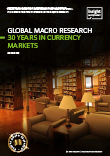Francesca Fornasari, Head of Currency Solutions
In 2023 Insight will have been actively managing currency risk for its clients for over 30 years. In this paper, our currency team looks at the incredible changes that have occurred in currency markets over this period and how approaches to currency management have evolved as a result.
As we contemplate the simplicity of transacting between different currencies in the modern world, it seems hard to believe that currencies have only been free-floating since the early 1970s. The previous system of fixed rate exchange rates, known as Bretton Woods, came to a close in 1971 when President Nixon ended the convertibility of the US dollar into gold. Although the period that followed was somewhat chaotic, it eventually led to the US allowing the dollar to become free-floating, and those events set the backdrop for huge changes across the world.
Globalization, the liberalization of capital accounts and booming tourism and migration have catapulted this relatively new asset class to become the largest and most liquid in the world. By 2022, daily turnover in global currency markets had reached close to $8 trillion – a tenfold rise since the early 1990s. Liquidity in currency markets now dwarfs that found in both equities and bonds.
The strategies used for currency management have become more complex as currency markets have grown, evolving to deal with volatile capital flows. This means that currency markets are no longer just a potential source of risk or of alpha but are increasingly used to add diversification.
Click to read the full whitepaper below
Most read
Global macro


April 2022
Global Macro Research: Modeling the persistence of US inflation
Liability-driven investment, Fixed income, Responsible investment


December 2023
Thoughts for 2024
Fixed income


May 2025
An esoteric Q&A: Structured credit’s cutting edge
Liability-driven investment, Fixed income


January 2025
 United States
United States
























